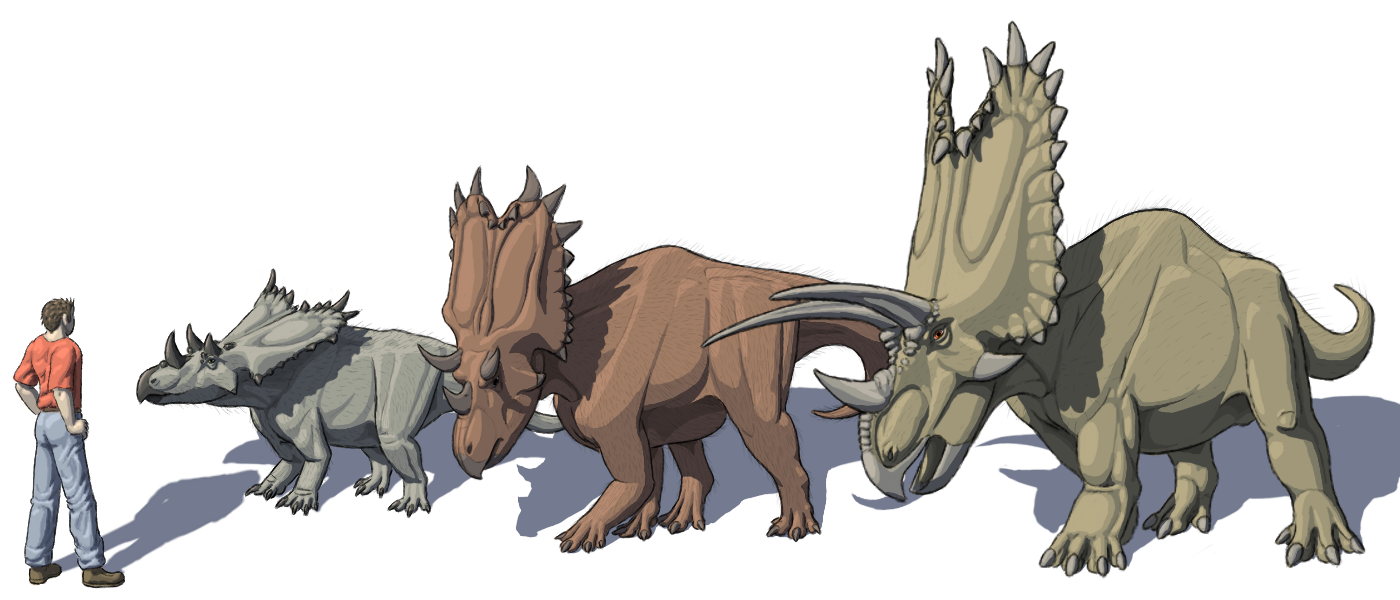
Ceratopsians were beaked dinosaurs with large heads, frills of bone extending in a shield from the back of their head, and compact torsos. Many had horns projecting from their noses, brows, or frills. Most were quadrupedal, although the earliest species were bipedal. Many species reached enormous sizes, rivaling modern elephants in overall mass.
Ceratopsians appear to be well adapted for eating tough, woody plants. Their strong jaws, shearing teeth, and sharp beaks could rip apart bark and wood to get at tender parts. The low heads of these dinosaurs would have restricted them to feeding on low growth, but they may have used their size and horns to push over taller trees. It is likely that they specialized in crunching up trees and bushes, perhaps largely eating cycads (superficially palm tree like cone bearing plants). In addition, they may have been more omnivorous than generally supposed. Some paleontologists liken them to giant swine, happy to take carrion or small prey in addition to their more usual vegetative fare.
Some ceratopsians are known to have traveled in large herds, which could number at least into the hundreds. These herds were likely migratory, wandering across the landscape like modern wildebeest or caribou. Not all species necessarily gathered in huge herds, however. It is likely that other ceratospian species would move in small groups; males may even be largely solitary outside of the breeding season.
The head frills and horns of the ceratopsians were almost certainly adapted for display, both to attract mates and intimidate rivals. If initimidation did not work, the horns could also be used to fight for dominance. This in turn indicates that ceratopsians had highly developed social interactions. However, the horns could certainly serve a secondary purpose as defense against threats.
Ceratopsins do not show any known sexual dimorphism - unusual for creatures with such elaborate displays and weaponry. However, some paleontologists are starting to think that what were previously considered separate species may in fact be different sexes or growth stages of the same species. Here, we assume that males tend to be a bit larger and more agressive than the females, the usual case when males compete for breeding rights by combat or feats of strength. However, the GM should feel free to change this as there is no real evidence to support it.
The compact bodies and powerful limbs likely made ceratopsians highly maneuverable, allowing them to quickly wheel about to face threats, keeping their sharp horns between more vulnerabile bits and the enemy. They were also likely capable of explosive bursts of speed, but may not have been able to sustain high speeds for long.
Many ceratopsians are known to have had skin covered in scales, but at least some are also known to have bristle or quill like structures. These options are not mutually exclusive - some specimens sported quills and also had scales.
Ceratopsians are known from Asia, Europe, and North America. In the late Cretaceous, North America was split into two sub-continents by the Western Interior Seaway, a shallow ocean that extended from the Gulf of Mexico through the modern Midwest. The eastern sub-continent was called Appalachia, the western sub-continent Laramidia. All North American ceratopsians are from Laramidia. They were common in Asia in the mid to late Cretaceous, although most Asian forms lacked horns and were modest sized. Most of the large and well-known ceratopsians, those with impressive horns, came from late Cretaceous Laramida.

| choose a species: | |||||||||
Marking the T? checkbox will give you the stats in template form with all costs listed, otherwise you get a stat sheet as for a character. Marking the HR? checkbox will print the information using all my house rules. Otherwise, the stats will be as compatable with plain vanilla GURPS as possible (although several custom advantages and disadvantages will be present, see my Traits page). |